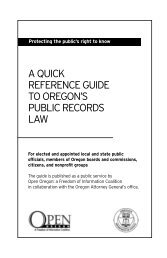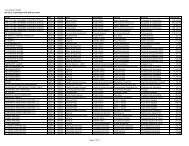Marc €- Setchko - Lane County Government
Marc €- Setchko - Lane County Government
Marc €- Setchko - Lane County Government
Create successful ePaper yourself
Turn your PDF publications into a flip-book with our unique Google optimized e-Paper software.
Jul 08 10 06:22p Jim Just<br />
dii'iew.<br />
I<br />
<strong>Marc</strong> <strong>€</strong>. Setchka<br />
CONSULTING FORESTER<br />
870 Fbx Glenn Avenue<br />
The <strong>Lane</strong> <strong>County</strong> Soil Ratings for Forestry and Agriculture (see Exhibit 4) show a<br />
site class rating for only two of these soil types, the McDuff clay loam and the Ritner<br />
cobbly silty clay loam. A cu.ftlac./yr. figure is also shown for these two soil types; only<br />
a cu.ft./ac./yr. figure is shown for the Dixonville-Philomath-Hazelair complex, it doea not<br />
have a site class rating. The remaining soil types are very poor conifer growing soils and<br />
are not assigned any forestland site class rating, in the <strong>Lane</strong> <strong>County</strong> Soil Ratings. The<br />
cu-ft-facJyr. growth, for these soil types, was obtained from the soil ratings shown in the<br />
Office of the State Forester Memorandum (see Exhibit 5). All of these soils are incapable<br />
of producing 85 cu.ft./ac./yr., the parameter used by <strong>Lane</strong> <strong>County</strong> for determining<br />
marginal soils.<br />
CUBIC FEET PER YEAR PER ACRE GROWTH<br />
The parcel was logged over the last ten years, before the current owners purchased the<br />
property. They have no records of the amount of timber removed. Therefore, the<br />
calculations of gr'owth were taken from the tables cited above and the potential income<br />
calculated from theses figures. In order to obtain a yearly growth figure, in cu.ftlac. for<br />
the entire parcel, the production potential of the different soil types was first calculated for<br />
the acres within each soil type. This will give a weighted figure for each soil type and can<br />
then be divided by the total acres for an overall average. These calculations are shown<br />
below.<br />
SoiI Type<br />
43C Dkonville-Philomath-Hazelair complex<br />
43E Dixonviile-Philomath-Hazelair complex<br />
8 1D McDuff clay loam<br />
102C Panther silty clay loam<br />
107C Philomath silty clay<br />
108F Philomath cobbly silty clay<br />
113C, E & G Ritner cobbly silty clay loam<br />
125C Steiwer loam<br />
Totals<br />
Acres<br />
6.64<br />
-44<br />
5.60<br />
14.68<br />
39.61<br />
30.20<br />
13.38<br />
3.19<br />
113.74<br />
.. Average Growth Potential - 113.74 Acres + 7,162.45 Cu.Ft. = 62.97 Cu.Ft./Ac./Yr.<br />
: AVERAGE GROSS ANNUAL JNCOME GENERATED PER YEAR THROUGH A :<br />
COMPLETE ROTATION<br />
Since no cutout records are avaiIabIe, the Empirical Yield Tables were used to obtain total<br />
volume per acre in scribner board feet volume, the measurement needed in order to<br />
calculate income potential. These yield tables are calculated using King's 50 year site class<br />
index. Since the <strong>Lane</strong> <strong>County</strong> SoiI Ratings for Forestry and Agriculture are based on<br />
McArdle's 100 year site index rating, these ratings must be converted first. Using the 50<br />
year Site Index ratings, for each different soil type, the volume per acre for each soil type<br />
can be calculated. Adding all the soil types together will give a total for the entire parcel.<br />
A fifty year rotation (growth cycle to f d harvest) was used. This time span was adopted<br />
as the standard, by a consensus of the Board of Commissioners in <strong>Marc</strong>h 1997, and is<br />
included in the Supplement to the Marginal Lands Information Sheet.<br />
-2-







